Israel
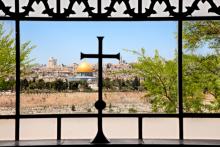
Is Christian Zionism good for the Jews?
Not every Jew thinks so.
In fact, Christian Zionists make many Jews crazy.
Why?
Worry No. 1: Christian Zionists believe all Jews need to be back in the land of Israel before Jesus can return.
Except it’s not true.
I once asked Ralph Reed, the prominent conservative activist and founder of the Christian Coalition, about this.
“Rabbi, I’ve been in church every Sunday of my life and I have never heard such a thing,” he said.

STUN GRENADES AND tear gas bombs exploded in the street outside of Bethlehem Bible College, forcing Rev. Alex Awad to end his class early. Down the block, youth threw stones at the Israeli separation wall that cuts deep into Bethlehem. Frequent clashes had erupted in the months since the Israeli offensive known as Operation Protective Edge killed more than 2,200 Palestinians in Gaza, most of them civilians. During that operation, 66 Israeli soldiers and seven civilians were killed by Gaza militants. In the months that followed, Jerusalem became the focal point of further violence.
“Many people ask, what are signs of hope?” says Awad. While the facts on the ground get worse, he names one encouraging trend: “Many evangelicals are moving from the Israeli side into what I think is the peace and justice side.”
Here are seven signs that he’s right:
1. Evangelicals are listening to Palestinian Christian voices. Jerusalem-born with a degree from a U.S. Bible college, Awad is uniquely suited to speak to evangelicals—including some unlikely guests. John Hagee, leader of Christians United for Israel, the U.S.’s largest Christian Zionist organization, arranged for five tour groups to visit Bethlehem Bible College. The first group arrived last August.

Let me tell you about a married couple. They have been together for many years. Their marriage has had some good moments, but there have also been periods of verbal and physical abuse. Finally, the wife tells her husband that she is considering leaving the marriage. She knows she has options. She can go to a shelter for battered wives, and even find her own place to live in safety and security.
As she starts her car in the garage, her husband runs after her. He drops to his knees and begs: “Please don’t go. I won’t be ‘me’ without you!”
Does she put her foot on the brake, shut off the engine and go back into the house? Does she stay in what has become a very troubled marriage?
That is precisely the question that many Jews in Europe have been asking themselves. More than 7,000 French Jews have moved to Israel in the last year, and there are clear signs others will follow.
This is huge. France has the third-largest Jewish community in the world.

IF WE FOLLOWED the church calendar and celebrated Epiphany in January, we wouldn’t have to cram the wise men into the crèche to compete with the shepherds. We could save all the “Star of Bethlehem” songs to brighten the cold days of January. Obviously, the magi needed a few weeks to prepare and then travel “from the East.”
A new bright object in the sky was certainly an “epiphany,” but it was not totally unexpected. These magi were astrologers, the ancient astronomers of their day. To the east of Jerusalem lay Babylon, birthplace of astrology and location of a large Jewish community. The discovery of two astrological books among the Dead Sea scrolls showed that the sign of Aries the Ram in the zodiac represented the reign of Herod the Great in Judea. Since Herod was aging, it is not surprising that Jewish astrologers were watching this royal constellation.
In a television series called Jesus: The Complete Story, astronomer Michael R. Molnar notes an unusual astrological conjunction on the night of April 17, in 6 B.C.E., the year Jesus was most likely born. At that time, both Saturn and the sun were in the constellation Aries, and then the moon eclipsed to reveal Jupiter, king of the planets, also in Aries. Jupiter shone into the dawn, another auspicious sign of royalty. It was confirmation enough to send these astrologers on their way.
Perhaps if we celebrated Epiphany after Christmas, we’d have more time to learn about this epiphany and its remarkable interpretation.
IN 1973, IMMEDIATELY following the Yom Kippur War, I watched the movie Exodus. I was so swept up by Leon Uris’ depiction of the Zionist struggle that I wrote in my journal, “The U.S. should do everything it can to defend the state of Israel!”
Two years later, I read a history of the Arab-Israeli conflict in a serialized encyclopedia of World War II. It transformed me into an impassioned defender of Palestinian rights. Clearly, the historical narrative one accepts is critical to determining how a conflict is understood.
Jo Roberts’ book Contested Land, Contested Memory: Israel’s Jews and Arabs and the Ghosts of Catastrophe challenges the nationalist mythologies of both Israelis and Palestinians, peoples largely in denial of each other’s histories. With exhaustive research and numerous personal interviews, Roberts has created a book that is both sensitive to and challenging for partisans of either side.
Roberts begins with the story of an Israeli Jew whose memories of idyllic childhood vacations in a particular village are shattered when she learns from a Palestinian boyfriend that his family was displaced from that village by Israeli soldiers in 1948. Roberts goes on to offer a history of Zionism that is not without its share of heartbreak. From persecution in Catholic Spain to the Dreyfus affair in France and government-sanctioned pogroms in Russia, she reminds us of the prevalence and ferocity of anti-Semitism, which led many to join the movement to create a Jewish state in Palestine. She includes a report to President Truman about 250,000 Holocaust survivors, who in late 1945 were still confined in former slave labor and concentration camps because no country, including the U.S., would accept them as refugees. Roberts makes a convincing case that many Jews went to Palestine because they literally “had nowhere else to go.”

LIKE MUCH OF the world, I’ve been thinking quite a bit about ISIS over the past few months. I’ve been horrified by the accounts of the so-called Islamic State’s barbarism, and I lament their perversion of one of the world’s great religions.
Most of all, I’m outraged at their disregard for human life—at their wanton killing of Shia Muslims, Christians, Yazidis, and anyone else who doesn’t share their radical vision. Pope Francis has said that it’s legitimate to act to protect innocent lives in this case, and I don’t disagree with him.
Yet I believe that Jesus calls us to be peacemakers, which requires us to think beyond short-term military solutions and address the systemic issues that breed crises like this one. And I strongly believe that to have any moral authority in the current crisis, we must first confess the Western policies and attitudes that have contributed to where we find ourselves today—and then repent of those policies and attitudes.
The first thing we need to confess is a shallow and, at best, incomplete understanding of ISIS. Alireza Doostdar of the University of Chicago Divinity School wrote, “[We] seem to assume that ISIS ... has suddenly materialized out of the thin ether of an evil doctrine. But ISIS emerged from the fires of war, occupation, killing, torture, and disenfranchisement. It did not need to sell its doctrine to win recruits. It needed above all to prove itself effective against its foes.”

A new institute in Jerusalem has been awarded $2.2 million to help Christians and Jews study Jewish texts, launching what’s being billed as a new kind of Jewish-Christian cooperation.
The Herzl Institute was awarded what’s being called the first ever multimillion-dollar grant in Jewish theology by the U.S-based Templeton Foundation, a philanthropic organization that has focused much of its giving on science-related projects. The Herzl Institute is a research institute that focuses on the development of Jewish ideas in fields like philosophy and history.
The institute is named for Theodor Herzl, considered the father of modern political Zionism, ideas that have found much support from conservative and evangelical Christians in the U.S.
Jewish and Christian collaboration has often been relegated to the political level, said Herzl President Yoram Hazony. The partnership reflects a new kind of engagement between Christians and Jews, he said.

WE LIVE IN A TIME of widespread violence. No country, no community, no person is untouched by violence. It is a complex problem stemming from our thought patterns and actions that are, in turn, shaped by various forces in our daily lives. Because violence is so complex, we often seek an easy answer—typically, naming a specific religion, culture, ethnicity, or nationality as a cause of the evil that perpetrates or stimulates violence.
But we all know that such scapegoating is another crime that only creates more violence. Each and every individual and community has good and bad, strength and weakness, merit and demerit. Just as no one is perfectly good, no one is perfectly evil. In her well-known book Eichmann in Jerusalem, philosopher and writer Hannah Arendt points out that evil is related to the lack of reflective thinking. “The longer one listened to [Eichmann],” writes Arendt, “the more obvious it became that his inability to speak was closely connected with an inability to think, namely, to think from the standpoint of someone else. No communication was possible with him, not because he lied but because he was surrounded by the most reliable of all safeguards against the words and presence of others, and hence against reality as such.”
For Arendt, to think reflectively means to be aware and to take into account the reality that one’s own life is always in relation to the lives of others. This is also what the biblical texts this month invite us to contemplate.

AS CHRISTIANS concerned about peace and justice, this time of crisis in the Middle East provides us an opportunity to return to our principles, the “springs of living waters” for people of faith:
- We need to oppose both anti-Semitism as well as any form of discrimination and racism against Palestinian Arabs. Solutions that promote or tolerate discriminatory and racist institutions and practices should be forthrightly condemned. Settlements, illegal under international law and discriminatory against Palestinians, need to be rejected rather than tolerated and legitimized.
- We need to work for justice, which requires that we work for a solution that levels the playing field rather than seek a “realistic” approach that reflects the balance of power between the parties, necessarily favoring the strong against the weak.
- We need to seek reconciliation and peace between the parties, rather than assuming eternal hostility and enmity between the parties.

My people have committed two sins: They have abandoned me, the spring of living waters, and have dug for themselves cisterns, broken cisterns ... that hold no water.
—Jeremiah 2:13
IN THE LATE 1980s and early '90s, Palestinians rose up against the Israeli occupation of Palestinian territories in what became known as the First Intifada. Instead of acceding to the demands for justice by the "children of the stones," the response was a process of talks that led to the signing of the Oslo Accords in 1993.
The “peace process” engaged the leadership of the PLO (Palestine Liberation Organization)—then weak, corrupt, exiled, and with little vision or support—in what turned out to be a worse-than-fruitless effort that led to the perpetuation of the occupation and suffering of the Palestinian people, and which made a just peace even further away.
The process was intriguing to many of us in the peace and justice community, and it successfully co-opted us, as it co-opted the Palestinian leadership, but this process entailed both the abandoning of principled positions and the adoption of the Oslo system, a broken system that could not possibly deliver what it promised.
We were treated to a new language by Israel and the U.S., which seemed at first blush to adopt our own slogans: Where Palestinians were constantly complaining of Israel’s refusal to acknowledge them—its demonization of their leadership, and trying to have Jordan or other local collaborators speak on their behalf—the new process brazenly invited the PLO itself and its leader Yasser Arafat to participate as the “sole legitimate representative of the Palestinian people.”
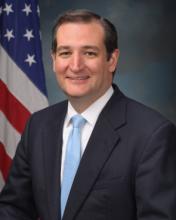
After he said “Christians have no greater ally than Israel,” Sen. Ted Cruz, R-Texas, was heckled off the stage at a Sept. 10 gala to raise awareness of beleaguered Mideast Christians.
Cruz, the keynote speaker at the Washington, D.C., dinner, sponsored by In Defense of Christians, a new organization spearheaded by Catholic and Orthodox Christians, prompted boos and cries of “stop it!” and “enough” and “no!” as an increasingly louder crowd told him to get off the stage.
The incident, first reported by the online news organization The Daily Caller, was captured on video by EWTN, the Catholic television network. The video shows that Cruz tried to continue speaking, but many in the audience, in a hotel ballroom, expressed anger when he included Hamas in the list of militants out to destroy religious minorities in the Middle East.

A soon-to-be college-bound Michael Brown is shot by Missouri police, reportedly while holding his hands above himself in surrender and while unarmed. The resulting protests turn violent, leading ultimately to police setting up barricades, complete with snipers, tear gas, and flash grenades. Local stores are decimated and scores are injured in the resulting tensions.
Not long ago, Eric Garner, another African-American man, died of suffocation while being submitted to a choke submission hold by a New York policeman.
Last year in North Carolina, a black man was shot 10 times by a policeman. And all of this is in the shadow the Trayvon Martin, whose tragic and unnecessary death, is still fresh in our minds and hearts.
As cited on the Economist website , it’s enough to elicit a grim question from Delores Jones-Brown, director of the John Jay College on Race, Crime and Justice. “People are asking,” she says, “Is it open season on us?”
Meanwhile, half a world away in Iraq, ISIS continues to wreak havoc, and the United States has resumed an airstrike campaign after a decade of military force trying to maintain a tentative peace in a fractured nation. Hardly a day goes by when we don’t have reports of more Israeli and Palestinian blood spilled over the historic Gaza conflict, and Russian President Vladimir Putin continues to — in the words of a recent TIME Magazine article — “create problems only he can solve.” All the while, he stokes resentments between east and west not seen since the Cold War, seeking, too, to weaken the cohesive strength of NATO and to drive a wedge between the United States and its allies in Europe.
What’s happening to us?

As the Father has loved me, so have I loved you. Abide in my love. If you keep my commandments, you will abide in my love, just as I have kept my Father's commandments and abide in his love. These things I have spoken to you, that my joy may be in you, and that your joy may be full. This is my commandment, that you love one another as I have loved you. Greater love has no one than this, that someone lay down his life for his friends. – John 15:9-12
War is always ugly. The loss of innocent lives is never easy to swallow. And yet, as tanks open fire on the humble homes of the Gazan poor and rockets rain down on a terrified Israeli populace we are compelled to ask, “How do we keep coming back to this profane and violent place called war?” Why do we consistently and continually fail to understand the simple principles of our own faith and the faiths of those who profess a belief in God?
These simple faith principles speak of a command to love one another and to have a deep and abiding respect for all life – especially innocent life. Then, why do we fail to love justice, peace, and mercy as God commands and seem so determined to visit such violence and destruction on our world and on one another?
Similar questions arise for me in my work as a pastor who labors in organizing people of faith to contend with the tough issues that we face daily in our country. Issues like the mass incarceration of our young, the struggle for human dignity by the poor, the lack of employment opportunities for those who desire only to feed their children and raise their families, and the millions who yearn to step out from the shadows of unjust immigration laws and be recognized as cherished citizens of an open and welcoming nation. These are the tough issues that bring me and so many other clergy and people of faith from the confines of the church into the streets and homes of those whose lives are tethered closest to the pain of injustice. In each of these instances the moral challenges seems so clear but the outcomes are incongruent with the faith principles that are designed to guide our hearts and direct our actions.
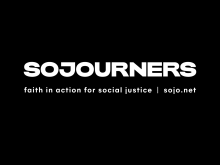
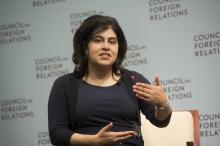
The first Muslim to serve in a British Cabinet resigned Tuesday over her government’s “morally indefensible” policies in Gaza and its role in the Middle East peace process.
Baroness Sayeeda Warsi, who served as senior Foreign Office minister for faith and communities, announced her decision on Twitter, saying: “With deep regret I have this morning written to the Prime Minister & tendered my resignation. I can no longer support Govt policy on #Gaza.”
In her resignation letter, Warsi wrote: “I believe our approach in relation to the current conflict is neither consistent with our values, specifically our commitment to the rule of law and our long history of support for International Justice.”
Labour leaders and human rights groups have criticized Britain’s Conservative government, led by Prime Minister David Cameron, in recent weeks for not unequivocally condemning Israel’s handling of the Gaza crisis.
Conservative leaders expressed disappointment over Warsi’s “unnecessary” resignation on Tuesday, while Labour opposition leader Ed Miliband said Warsi had acted with “principle and integrity” in deciding to step down.
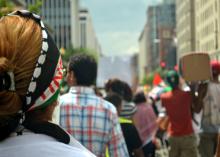
Saturday marked the third time since Israel began military operations in Gaza on July 8 that I let my voice be heard. I stood and marched alongside some 20,000 other individuals that like me have become utterly disgusted by what is unfolding in the Middle East.
A cease-fire has been struck, but as of yesterday, at least 1,800 Palestinians, most of whom are civilians, have been killed and nearly 7,000 have been wounded. Another 200,000 have been displaced in a territory whose infrastructure is now in ruins with mass power and water outages.
Despite the horrific events that have happened halfway across the world, the protest last Saturday, which took place at the White House, was a beautiful sight. Among the 20,000 protesters were Muslims, Jews, and Christians. There were blacks, whites, Arabs, Asians, and Latinos. There were women and men, both young and old, who had come from cities like Chicago, Tampa, Baltimore, and Boston. Many barriers were broken as we stood and marched in solidarity with the people of Palestine.
There were times when my heart was completely broken as I saw signs with photos of dead and mutilated bodies and others that listed the names and ages of children who had been killed by Israeli airstrikes. But in those same moments I would look across the sea of protesters draped in black, white, green, and red yelling phrases such as "Free, Free Palestine!" and "Stop the killing, stop the hate!" and I would once again become a prisoner of hope. I take refuge in the rock that is Christ Jesus. I know my God stands with those being oppressed, with those seeking justice and peace. I know my voice and prayers along with millions of others around the world will be heard.
Although I am pro-Palestine, that does not make me pro-Hamas or anti-Israel. I recognize and condemn Hamas's involvement in the failed peace talks and inability to find solutions. I also mourn equally for the loss of life on the Israeli side. However, despite the part Hamas has played in all of this I do not find Israel's actions to be justified. So I march.
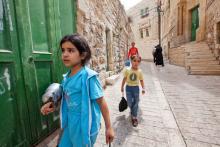
In the Judeo-Christian tradition, God calls us to love and show compassion to the stranger, particularly those who suffer. But first, they must become real to us. And there is nothing more viscerally real, perhaps, than the face of a dead child.
Is it possible to let our hearts by broken by the dead children of our enemy? Is our God big enough to allow us to imagine that God loves those we fear and despise?
Not until, I believe, they have faces.
Iraq, Syria, Ukraine, Israel, Gaza – though religious fervor is alive and well in these embattled areas, loathing, horror, and hatred seem to reign, darkness to rule. In the grim night, we cannot see each other’s faces.

The first thing that visitors and volunteers see at the Tent of Nations just outside of Bethlehem is a large stone on which are written the words, “We refuse to be enemies.” As Israeli settlements draw ever closer to their land and the Israeli Defense Forces destroy their orchards, the Nassar family continues to pay a heavy price in their practice of Jesus’ teaching, “Love your enemies, do good to those who hate you, bless those who curse you, pray for those who abuse you (Luke 6:27-28).”
The Nassars refuse to divide the world into friends and enemies, challenging the rest of us to do the same.
As a Christian, I was raised to be pro-Israel. Since going to the region many times, I’ve become pro-Palestinian and pro-peace, too, which has led me to explore the narratives of Palestinians as well as Israelis. I grieve the deaths in both Israel and Palestine. Every human life has extraordinary value. The loss of even one life is a loss to all of us.

When the Word becomes flesh, when the Son of God becomes one who bleeds, Jesus demonstrates God's humble solidarity with human nature from Adam and Eve onward, to the last person born in history.
This vulnerability of God for us, this identification of Jesus with our collective human frailty, changes our perspective on everything. In the light that shines from the face of Jesus Christ, we at last see God and humanity with 20/20 vision.
Paul comes to this vision late in the day, well after the events of God in the flesh that reconcile the Father to God's creation. The vision of Jesus blinds him but when his eyes are healed, having seen Jesus, he sees God and humanity and the world very differently than he did before the vision of Christ that overwhelms him.
Years later, in a letter to the Corinthians, speaking about the church's worship with blest eyes he writes: "When we drink from the cup we ask God to bless, isn't that sharing in the blood of Christ? When we eat the bread we break, isn't that sharing in the body of Christ?"
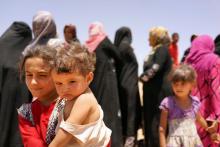
The horrible human costs and increasing danger the world is now facing in Gaza, Ukraine, and Iraq show the consequences of not telling the truth. And unfortunately, we seem to mostly have political leaders who are unwilling to admit the truth of what’s happening, deal with root causes instead of exploiting symptoms, and then do everything possible to prevent the escalation of violence and further wars. Instead we have politicians who are mostly looking for opportunities to blame their political opponents, boost their own reputations, and protect business interests. As people of faith, we are called to speak the truth in love.
It’s time for some truth telling.